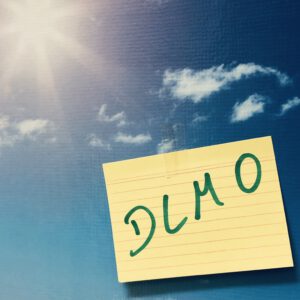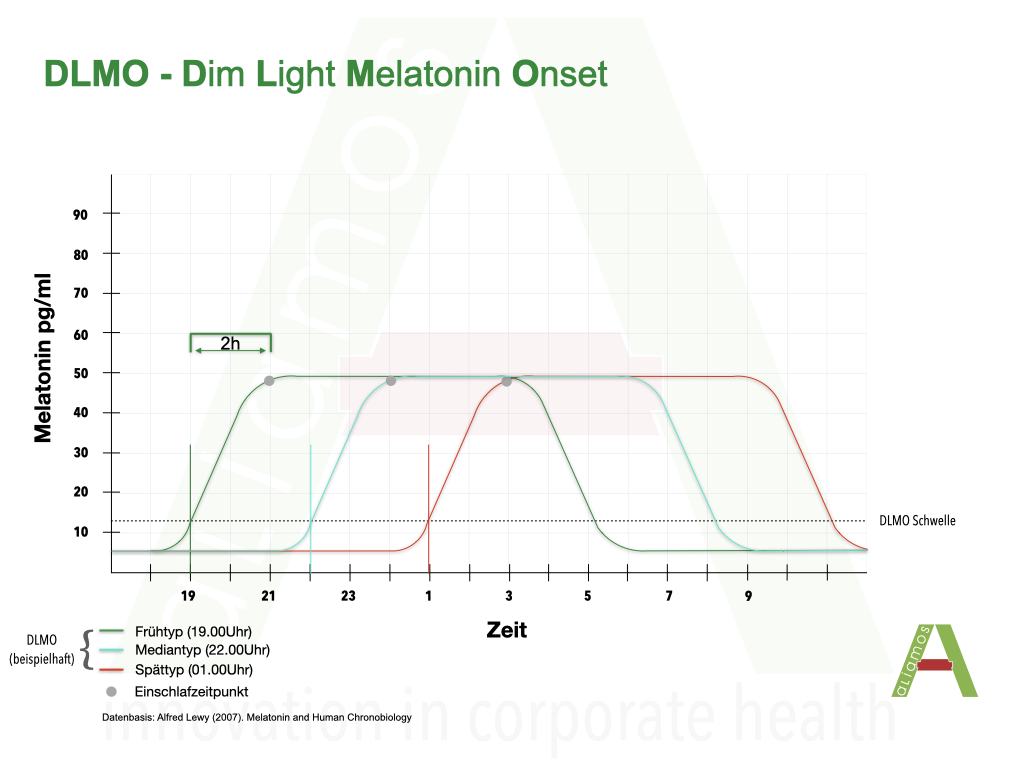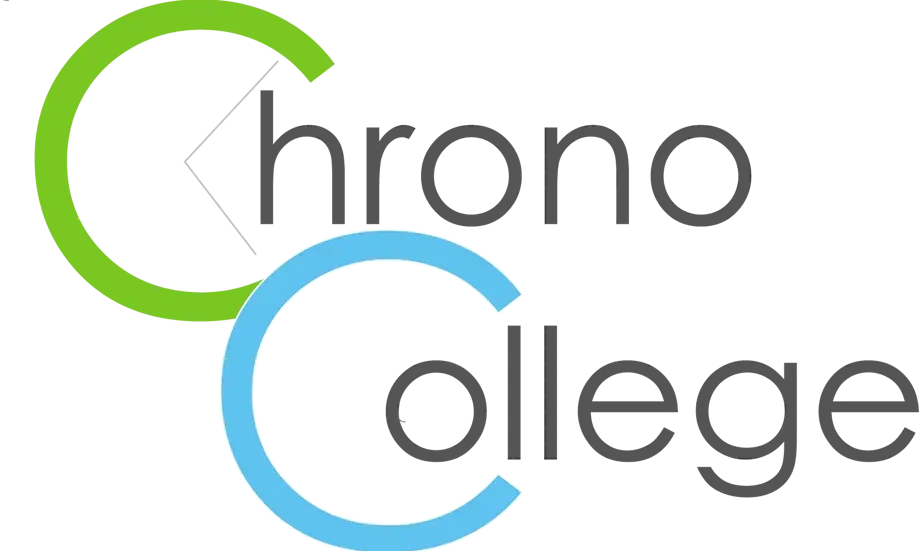
Very few people will have come across the term DLMO so far. In addition to scientists, it will be known mainly to those who have been chronotyped in our projects. Whoever orders the blood test for chronotyping receives a time point as a result, i.e. the DLMO. But what exactly is the DLMO? We give you an answer.
DLMO
It is usually pronounced “Dilmo” and stands for DimLight Melatonin Onset. Simply put, this is the time in the diurnal cycle when natural melatonin1-Ausschüttung massively increases above a certain threshold to prepare the body for sleep through processes based on it. The DLMO is usually defined as the time at which melatonin levels are continuously above a threshold of 10 pg/ml in plasma (DMLO10) or 3 pg/ml in saliva (DMLO3)2. Melatonin is also called the “sleep hormone”, and is the counterpart to serotonin, which is called the “wake-up hormone”.
DLMO and the genes
Now, the DLMO or its temporal position is not a product of chance. Like our internal clock, this time in the diurnal cycle is genetically determined, and varies greatly between people. Even though the designation “DimLight” could suggest a direct connection with evening light, the values show a very large variance. Within the scope of our studies, DLMOs between 15.42h and 00.23h, measured in daylight saving time, are already evident in the bandwidth of just under 135 persons tested. However, at 3:42 p.m. it is not yet evening light, and at 12:23 a.m. it is already deep night. This shows that the basic impulse is precisely not the sun, but genetic. This has already been shown by the Andechs bunker experiments. So it is not that evening light per se is the trigger for melatonin release, however, too bright light and a high blue content in the sunlight arriving on earth in turn has the effect of inhibiting melatonin release. The morning sunlight arriving on Earth has a high blue content until early afternoon, which suppresses the production of melatonin and favors the release of serotonin.
From DLMO to chronotype
This range within the measured DLMO time points reflects the range of chronotypes. We will explain how to get from the DLMO to the chronotype with an example.

In the graph on the left (Fig.1), 3 curves can be seen. These show the course of the melatonin level of an exemplary early type, median type and late type in the diurnal cycle.
A certain amount of time elapses after this threshold is reached before actual sleep occurs. This period is between 90 and 150minhttps://www.rug.nl/research/portal/files/47169194/Chapter_8.pdf depending on various parameters (sleep pressure, stress, etc.)3 For this reason, the calculation is based on an average value, which is usually either 1 ½ or 2h. As the amount of data (testing) increases, more precise information will be possible in the future. In the graph we have assumed 2h. You see an example of a DLMO of an early type from 19.00h (green). Here, the natural time to fall asleep is around 9:00 p.m. on average.
Why an early type is not always an early type
Whether a DLMO of 7:00PM is an early or normal type depends largely on where he is in comparison to all other tested persons. The usual comparison is with the population of a country. However, it may be that an international comparison already looks different again. For example, a DLMO of 23.00 is a normal type compared to all tested people in Germany. However, if all people in Europe were compared, the ratio may change again.

In the graph on the right (Fig. 2), as an example, is the distribution of chronotypes within the Wartenberg Clinic, which was determined as part of the COPEP project. In this case, this coincides with the distribution of chronotypes in Germany in general.
Nature doesn’t know time
Even if the DLMO is represented in the form of a point in time, one must be aware that nature does not know seconds, minutes or hours. As a measured value, the DLMO always represents a snapshot. This is comparable to the heartbeat. When we measure the pulse, the value displayed is always a snapshot and not a fixed value set in stone. As soon as the situation changes (e.g. due to sports), the pulse also adjusts. A fixed pulse, no man would survive long. Nevertheless, each person has an individual resting pulse within a certain range. Similarly, the DLMO does not primarily adapt to behavior (e.g., sports, work schedules) but primarily to changes in diurnal variation (e.g., flights to other time zones and/or sunshine duration, e.g., winter/summer).
Conclusion
So if the DLMO will form a basis for various purposes in the future (e.g. chronotype-oriented working times, therapy times, school times, etc.), it must always be kept in mind that a minute-based division has a purely planning sense, but does not reflect a continuously exactly equal state of the internal clock. Furthermore, it is definitely currently the most significant, but not the only marker of the internal clock.
For the first time, the DLMO opens the door to a sound basis for incorporating the individual day-after-rhythm, and thus an important component of health for every person, into the temporal order of our society in the form of a win-win situation for all involved.
By the way, you can read what happens to the DLMO in the summertime here.
Scientific advice: Dr. Giulia Zerbini
Zu allen Themen bietet Michael Wieden (aliamos GmbH) Vorträge an. Einen Überblick finden Sie hier. | Sie wollen Feedbacks zu den Vorträgen sehen? Die haben wir hier. | Abonnieren Sie den aliamos Newsletter |
|---|
Michael Wieden beschäftigt sich als Betriebswirt seit 2002 mit der Chronobiologie im Personalmanagement. Schon 2003 hielt er hierzu seinen ersten Vortrag auf einer Veranstaltung der INQA (Initiative der neuen Arbeit).
Zu den Themen „Chronobiologie im Personalmanagenement“ sowie mobilen Arbeitsformen hat er bereits Bücher geschrieben, und dabei den Begriff „Liquid Work®“ geprägt.
Zusammen mit Claudia Garrido Luque gründete er 2014 die aliamos GmbH und berät seit dem Kommunen, Unternehmen und Kliniken zum Betrieblichen Gesundheitsmanagement. Von 2012 bis Ende 2016 war er externer Wirtschaftsförderer für die Stadt Bad Kissingen und Initiator des weltweit einzigartigen Projektes „ChronoCity – Pilotstadt Chronobiologie“. Zu ChronoCity®, Chronobiologie-Themen und mobilen Arbeitsformen trat er wiederholt als Experte in verschiedenen Fernsehformaten (z.B. TerraX, Planet Wissen, W wie Wissen, Xenius etc.) auf. Zudem war er von 2014 bis 2017 Mitglied des Arbeitskreises „Zeitgerechte Stadt“ der ARL – Akademie für Raumforschung und Landesplanung in Hannover.
Aktuell hält er Vorträge zum Thema “Chronobiologie im Personalmanagement” und “Mobile Arbeitsformen”, und berät Unternehmen bei der Umsetzung chronobiologischer Ansätze in Unternehmen und Kliniken.
